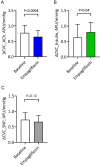The effect of empagliflozin on peripheral microvascular dysfunction in patients with heart failure with preserved ejection fraction
- PMID: 40281528
- PMCID: PMC12023568
- DOI: 10.1186/s12933-025-02679-8
The effect of empagliflozin on peripheral microvascular dysfunction in patients with heart failure with preserved ejection fraction
Abstract
Background: Empagliflozin is an effective treatment for heart failure with preserved ejection fraction (HFpEF), but its definite mechanism of action is unclear. Systemic microvascular dysfunction strongly relates to HFpEF aetiology, and we hypothesised that empagliflozin improves microvascular function in HFpEF.
Objective: To investigate the effect of the sodium-glucose cotransporter-2 inhibitor empagliflozin on peripheral microvascular function in HFpEF.
Methods: This is a pre-post intervention study in patients diagnosed with HFpEF who are eligible for treatment with empagliflozin. Microvascular function assessment using laser speckle contrast analysis of the dorsal forearm during iontophoresis of vasoactive stimuli (acetylcholine, insulin sodium nitroprusside) was performed at baseline and after 3 months of empagliflozin treatment (10 mg daily). The primary outcome was the difference in blood flow measured in the forearm microvasculature between baseline and at follow-up (cutaneous vascular conductance, CVC). Secondarily we investigated quality-of-life based on the EQ-5D-5 L questionnaire at baseline and follow-up.
Results: Twenty six patients finished the study according to protocol (mean age of 74 ± 7 years, 62% female). We observed a decreased blood flow response to acetylcholine after 3 months of empagliflozin (CVC: 0.77 ± 0.24 vs. 0.64 ± 0.20, p < 0.001). In contrast, the response to insulin improved (CVC: 0.61 ± 0.43 vs. 0.81 ± 0.32, p = 0.03), and the response to sodium nitroprusside remained stable after 3 months. No significant correlations were found between the changes in blood flow and quality of life.
Conclusion: This study shows that three months treatment with empagliflozin changed peripheral microvascular function in patients with HFpEF. Empagliflozin may enhance microvascular blood flow specifically via vascular actions of insulin, rather than a general effect on endothelial vasoregulation or smooth muscle cell function. As such, systemic microvascular dysfunction can be a modifiable factor in patients with HFpEF, while the clinical implications thereof warrant further investigations.
Trial registration: The trial was preregistered at clinicaltrials.gov (NCT06046612).
Keywords: Acetylcholine; Endothelial function; Heart failure; Insulin; Laser speckle contrast analysis; Microcirculation; Nitroprusside; SGLT-2 inhibitor.
© 2025. The Author(s).
Conflict of interest statement
Declarations. Ethics approval and consent to participate: This study complies with the declaration of Helsinki and was approved by the Medical Ethics Committee University Hospital Maastricht/ Maastricht University as a low-intervention clinical trial according to the Clinical Trial Regulation (EU CT 2022-501682-45). All patients provided written informed consent before enrolment. Consent for publication: Not applicable. Competing interests: V.P.M.v.E received sponsoring/grants from Roche, Vifor Pharma, Boehringer Ingelheim, Astra Zeneca and Pfizer (paid to institute), and received consultancy fees from Novartis, Janssen, Boehringer Ingelheim, Novonordisk (paid to institute).Pfizer and Astra Zeneca provided an unrestricted research grant to Maastricht University Medical Centre.C.K. received consulting fees from Pfizer, Novartis, BMS, and Alnylam (paid to institute).J.W. received grants from Corvia Medical, CSL Vifor, and Boehringer Ingelheim and is a member of the scientific committee on Atrial Disorders of the Heart Failure Association of the European society of cardiology.
Figures






References
-
- Arnold JR, Kanagala P, Budgeon CA, Jerosch-Herold M, Gulsin GS, Singh A, Khan JN, Chan DCS, Squire IB, Ng LL et al. Prevalence and prognostic significance of microvascular dysfunction in heart failure with preserved ejection fraction. JACC: Cardiovasc Imaging 2022. - PubMed
-
- Paulus WJ, Tschöpe C. A novel paradigm for heart failure with preserved ejection fraction: comorbidities drive myocardial dysfunction and remodeling through coronary microvascular endothelial inflammation. J Am Coll Cardiol. 2013;62(4):263–71. - PubMed
-
- Lam CSP, Voors AA, de Boer RA, Solomon SD, van Veldhuisen DJ. Heart failure with preserved ejection fraction: from mechanisms to therapies. Eur Heart J. 2018;39(30):2780–92. - PubMed
-
- Yang JH, Obokata M, Reddy YNV, Redfield MM, Lerman A, Borlaug BA. Endothelium-dependent and independent coronary microvascular dysfunction in patients with heart failure with preserved ejection fraction. Eur J Heart Fail. 2020;22(3):432–41. - PubMed
Publication types
MeSH terms
Substances
Associated data
Grants and funding
LinkOut - more resources
Full Text Sources
Medical
Research Materials

